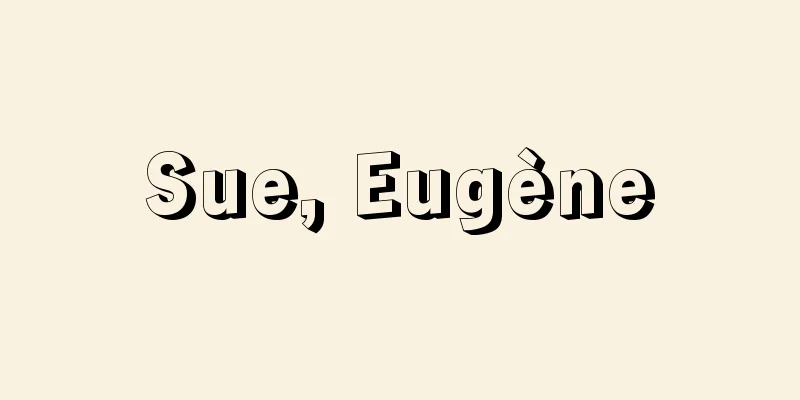Costume - Costume

|
To wear a mask or other costume to assume a certain appearance. It is said to have originated from magical and religious rituals, and ancient cave paintings in southern France from the Paleolithic period show images of wizards dressing up as reindeers. Such magical costume customs associated with rituals can still be seen today. There are various purposes and methods, but for example, Native Americans hold a pre-blessing ritual in which they surround a person dressed as a game such as a wild buffalo, dance in a group, and pretend to kill the game, praying for a bountiful hunt. There are also tribes such as the Twewa people who have passed down a dance in which they dress up as an eagle, a symbol of Native Americans and believed to have magical powers. The Abelam people of New Guinea make statues called Gwarunzu, which represent the spirits of the tribe, for various ceremonies, including the coming-of-age ceremony. Sometimes, tribe members dress up as Gwarunzu by wearing huge feather ornaments on their heads and painting their faces gold. In villages in Nigeria, West Africa, costumes are worn at funerals and festivals to represent the world of the dead and the arrival of ancestors, but some tribes, such as the indigenous Tikuna people of South America, wear masks and costumes depicting imaginary animals for rites of passage. These magical costumes, intended to ward off demons and communicate with divine spirits, developed into theatrical forms such as Greek tragedies, and were passed down to enthusiastic festivals such as carnivals. In Japan, the Nihon Shoki records how Emperor Yamato Takeru transformed himself into a girl and defeated the Kumaso, and cross-dressing later became a major feature of Kabuki. Japanese performing arts often involve the use of masks and costumes to represent gods, Buddhas, animals, birds and so on. Among these, there are some performing arts that are still passed down today, such as the Shishiodori (Deer Dance) of the Tohoku region, which are thought to have originated from the hunting lifestyle of ancient peoples. [Shigeru Takayama] In all human societies, various elements of the body are endowed with meanings that go beyond the subject's merely practical functions, such as the subject's social status, role, or aesthetic dimension, and a change in attire also implies a change in the subject's persona (personality = mask). When a specific purpose or intention is emphasized in the process of transition from "self" to "other" accompanying the change in attire, it is called disguise, and when a ritual aspect is emphasized (pilgrimage, etc.), it is called masquerade. In other words, when masquerading, a framework that clearly indicates that the situation is out of the ordinary must be assumed. For example, the Iatmul society living in the New Guinea highlands has a ritual called naben, in which cross-dressing (men dressing as women and women dressing as men) is observed. Men dressed as women wear the most vulgar and filthy widow's mourning clothes, apply eye-catching makeup to their faces and limbs, and exaggerate the gestures of an old woman while using a woman's cane. By inverting real social relations, Narben has the function of ritually resolving the contradictions inherent in social structures, and costumes are an essential catalyst for the functioning of such a cultural device. In addition, traditional European carnivals featured cross-dressing, animal dress, grotesque dress (dressing as imaginary monsters or clowns), and eccentric dress (dressing up in a way that reverses one's social status). There are many variations in the types of costumes, but in all cases they are important opportunities to reverse or nullify the various hierarchical orders that make up everyday life (male/female, human/animal, culture/nature, etc.). In a festive space, humans become extraordinary and surrealistic beings through costumes. The deviance inherent in such costumes can sometimes transcend given cultural frameworks and even become an opportunity to spark a popular movement, as seen in the "Eejanaika" movement (where cross-dressing, dancing, and half-naked appearances were seen). Finally, it is also important to recognize that while costumes are a phenomenon found in all human societies, they are losing their symbolic depth as modernization progresses. [Tosa Masaki] "The Hermeneutics of Masks" by Megumi Sakabe (1976, University of Tokyo Press) "Metamorphosis" by Tokutarou Sakurai et al. (1974, Kobundo) [Reference] |Source: Shogakukan Encyclopedia Nipponica About Encyclopedia Nipponica Information | Legend |
|
仮面をつけたり、扮装(ふんそう)などを施して仮にある姿を装うこと。その起源は呪術(じゅじゅつ)的・宗教的儀礼に発するといわれ、古くは旧石器時代の南フランスの洞窟(どうくつ)壁画に魔法使い扮するトナカイの画(え)が描かれている。このような儀礼に伴う呪術的な仮装の風習は、今日でも散見される。その目的と方法はさまざまであるが、たとえば、北米先住民は、野牛など獲物となる扮装をした者を取り囲み、群舞しながら、その獲物役の者を殺すまねをして狩りの豊饒(ほうじょう)を願う予祝(よしゅく)儀礼を行う。またトウェワ人のように、先住民の象徴であり呪力を有するとされているワシに扮する踊りを伝えている部族もある。ニューギニアのアベラム人は、成年式をはじめさまざまな儀礼にグワルンズという氏族の精霊を表す像をつくるが、ときには部族の者が頭に羽根でつくった巨大な飾りをつけ、顔を金色に塗ってグワルンズに扮する。西アフリカのナイジェリアの村では、葬式や祭礼のおりに死者の世界や祖先の到来を示す仮装が行われるが、南米先住民のティクナ人のように、想像上の動物を表した仮面つき装束を通過儀礼に用いる部族もある。これら悪魔退散や神霊との交信を目的とする呪術的な仮装は、一方ではギリシア悲劇のような演劇形態へと発展していき、一方ではカーニバルのような熱狂的な祭りに受け継がれていった。日本では日本武尊(やまとたけるのみこと)が少女に姿を変えて熊襲(くまそ)を討伐したようすが『日本書紀』に記されているが、女装はのちに歌舞伎(かぶき)の大きな特色となった。日本芸能には仮面・扮装を用いて神・仏・動物・鳥などを表すものがたいへん多く、そのなかには東北地方の鹿踊(ししおどり)のように、もともとは古代の狩猟生活に発したと思われるような芸能が今日なお伝えられている。 [高山 茂] あらゆる人間社会において、身体にまとうさまざまな要素は、主体の社会的地位、役割や美的次元などの単なる実用的機能を超えた意味を付与されており、装いの変化は主体のペルソナ(人格=仮面)の変化をも暗示することになる。装いの変換に伴う「自己」から「他者」への移行の過程において特定の目的や意図が強調される場合(隠密など)にこれを変装とよび、儀礼的な側面が強調される場合(巡礼など)にこれを仮装とよんでいる。つまり、仮装の場合には、明らかにそこが非日常的な状況とわかるような枠組みが前提とされなければならない。たとえば、ニューギニア高地に住むイアトムル人の社会には、ナーベンとよばれる儀礼が存在するが、そこでは異性装(男性が女装し、女性が男装すること)がみられる。女装した男性は、もっとも下品で不潔な未亡人の喪服を身にまとい、顔や手足に人目をひく化粧を施し、女性用の杖をつきながら老女のしぐさを大げさに演じてみせる。ナーベンは、現実の社会関係を反転させることで、社会構造がはらむ矛盾を儀礼的に解消する機能をもつが、仮装は、そうした文化的装置が機能するための不可欠な契機となっている。 また、ヨーロッパの伝統的カーニバルでは、異性装、動物装、異形装(想像上の怪物や道化の扮装をすること)、異階装(社会的身分を逆転させた扮装をすること)などがみられた。仮装の内容には多くのバリエーションがあるが、いずれの場合も、日常を構成するさまざまな階層的秩序(男/女、人間/動物、文化/自然など)を逆転あるいは無効にする重要な契機となっている。人間は、祝祭的空間のなかで、仮装を通じて非日常的で超現実的な存在になるのである。こうした仮装のもつ逸脱性は、たとえば「ええじゃないか」(異性装、踊り姿、半裸姿などがみられた)にみられるように、ときとして所与の文化的枠組みを超え、民衆運動の口火を切る契機となることさえある。 最後に、仮装はあらゆる人間社会にみられる現象であるが、近代化の進行とともにその象徴的厚みを失いつつあるという事実も認識する必要があると思われる。 [土佐昌樹] 『坂部恵著『仮面の解釈学』(1976・東京大学出版会)』▽『桜井徳太郎他著『変身』(1974・弘文堂)』 [参照項目] |出典 小学館 日本大百科全書(ニッポニカ)日本大百科全書(ニッポニカ)について 情報 | 凡例 |
Recommend
Geography - Chishi
Geography is a science that deals with various re...
Potamogeton cristatus (English spelling)
…[Maki Sachiko]. . . *Some of the terminology tha...
Okura - Okura
〘Noun〙① Along with the Imikura and Uchikura , it i...
Ornithorhynchus anatinus; platypus; duckbill
A monotreme member of the Platypus family. Body le...
perfect rime
...A simple rhyme is one that rhymes with stresse...
Yen shift - Yen shift (English spelling)
This refers to a shift from foreign currency finan...
Wilhelm Groener
German soldier and politician. He was involved in...
Madina al-Salām (English spelling)
…Construction began in 762, and after 100,000 wor...
cruise missile
...Furthermore, based on these missile technologi...
Erythromycin
An antibiotic that is effective against gram-posit...
Atil - Atil
…Being located on the border between Asia and Eur...
Carousel - Carousel
〘 noun 〙 One of the rides at an amusement park. A ...
isobtylene-isoprene rubber
…A synthetic rubber obtained by cationic copolyme...
Funds position - Shikin position (English) Bank's reserve position
This refers to the total of a bank's call loan...
Scalopus
…Many species have orange spots on the underside....






![Vinson [Mountain] - Vinson](/upload/images/67cca818cf172.webp)


